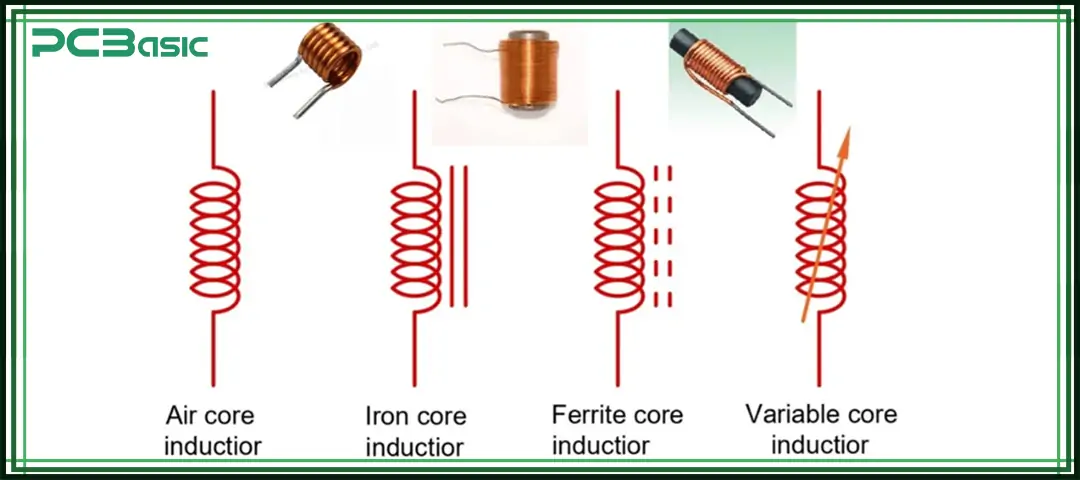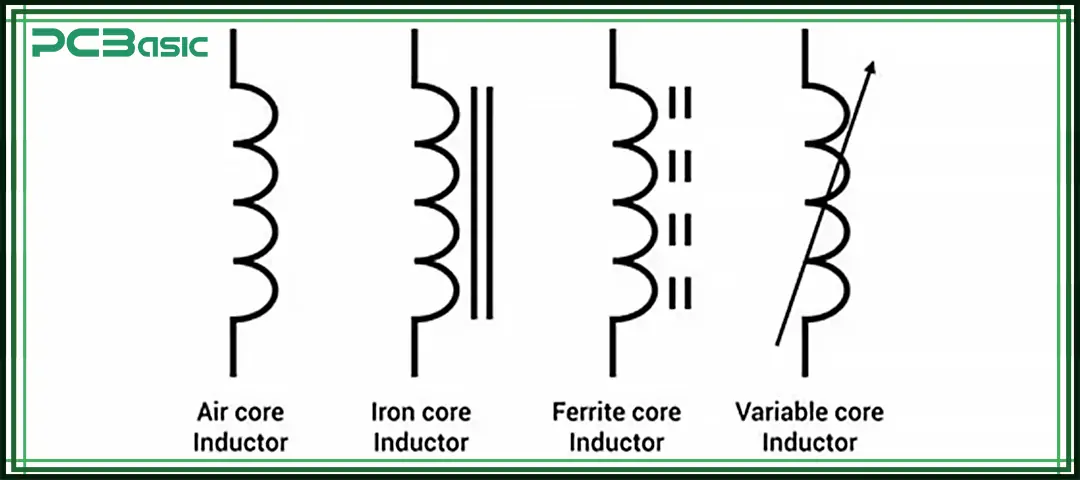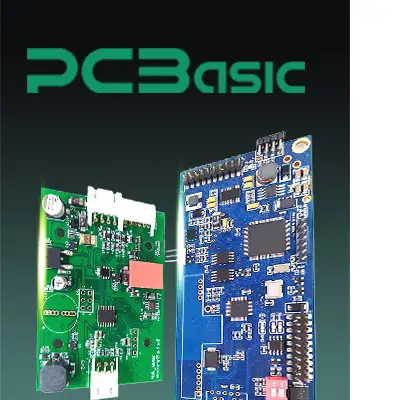

Global high-mix volume high-speed PCBA manufacturer
9:00 -18:00, Mon. - Fri. (GMT+8)
9:00 -12:00, Sat. (GMT+8)
(Except Chinese public holidays)


Global high-mix volume high-speed PCBA manufacturer
9:00 -18:00, Mon. - Fri. (GMT+8)
9:00 -12:00, Sat. (GMT+8)
(Except Chinese public holidays)
HomePage > Blog > Knowledge Base > Inductor Symbol Explained: Understanding Inductors in Circuits
The prerequisite for designing and analyzing a circuit is that you need to have a thorough understanding of the function of each component and its representation in the circuit diagram, that is, its symbol. An inductor is a common and extremely important component, widely used in various circuits such as filtering, energy storage, oscillation, and power supply voltage regulation. Mastering the working characteristics of inductors and the methods of drawing recognition not only helps us improve the efficiency of reading circuit diagrams and the accuracy of circuit design, but also enables us to quickly locate the position of inductors in circuits and determine their specific roles in signal paths or power management.
This article will provide you with a comprehensive introduction to inductors, including their definition, functions, working principles, as well as different types of inductors and their symbols. At the same time, you will also understand the practical application of inductor formulas and analyze the mathematical relationship between the voltage across the inductor and the current changes. It is hoped that through this article, you can build a complete knowledge system of inductors and lay a solid foundation for your subsequent in-depth study of electronic technology.

An inductor is a very common electronic component in the electronics industry. It is a passive device with two terminals (dual-end). When current flows through an inductor, it does not pass through immediately but generates a magnetic field around the inductor coil and temporarily stores energy in this magnetic field. That is to say, the function of an inductor is to store electrical energy with a magnetic field. This is the most core characteristic of an inductor.
Generally speaking, an inductor is composed of a coil made of conductive wires. To enhance its energy storage capacity, the coil is usually wound around ferromagnetic materials such as an iron core and ferrite, thereby increasing its inductance value, which is also known as "inductance". The magnitude of the inductance determines how much magnetic energy the inductor can store: the higher the inductance, the more magnetic energy the inductor can store. The inductor unit is measured in henries (H), and common smaller inductor units also include millihenries (mH) and microhenries (μH).
The main function of an inductor in a circuit is to suppress the variation of current. That is to say, when there is a risk of a sudden increase or decrease in current within the circuit, the inductor will generate resistance to oppose such changes. Unlike resistors, inductors only function when the current changes, specifically resisting rapid changes in current. A resistor, on the other hand, provides a constant resistance regardless of whether the current changes or not.
It is precisely because of this characteristic of suppressing current changes that inductors are widely used in various circuits.
For example, in low-pass filters, inductors can prevent the passage of high-frequency signals and only allow low-frequency signals to be transmitted smoothly. In the field of power conditioning, inductors are used to stabilize the current, suppress voltage spikes and filter out noise in the power supply.
In addition, inductors are also used in signal processing circuits, in combination with capacitors, to select signals of specific frequencies. In DC-DC converters, inductors also undertake the crucial task of energy storage - they store magnetic energy during the switching process of current and release it when needed, thereby enabling voltage step-up or step-down operations.
To understand how an inductor works in a circuit, we can start from the basic physical principles behind it. When current flows through the coil of an inductor, a magnetic field is generated around its winding. As the current increases or decreases, the magnetic field also changes. According to Faraday's Law of Electromagnetic Induction, any change in the magnetic field will induce a voltage in the inductor - also known as the electromotive force (EMF), whose direction is opposite to that of the current change. This is precisely the most fundamental working principle of an inductor.
We can express this phenomenon using the standard inductor formula:
V = L × (dI/dt)
Where:
• V = voltage across the inductor, measured in Volts
• L = Inductance, measured in Henries, which is the standard inductor unit.
• dI/dt = Rate of change of current (amperes per second)
From this inductor formula, we can clearly see that the voltage across the inductor is directly proportional to the rate at which the current changes. If the current changes very rapidly, the inductor will generate a large opposing voltage.
In addition to the formula in differential form, there is also an inductor current formula in integral form:
I(t) = (1/L) ∫ V dt
This formula indicates that when a voltage is applied across an inductor, the current will gradually increase over time. This ability to smooth out current changes is a key characteristic for inductors to achieve current regulation, and it also makes them indispensable components in circuits that require stable and continuous current.
In terms of measurement and component selection, inductor units mainly include the following:
• Henries (H): An international standard unit, often used to describe larger inductance values;
• MilliHenries (mH): 1 mH = 0.001 H;
• MicroHenries (µH) : 1 µH = 0.000001 H.
In practical applications, the inductance of most inductors is within the range of mH or µH, and rarely exceeds 10 H. The greater the number of turns in the coil or the use of better-performing magnetic core materials, the greater the inductance value. These parameters directly affect the performance and efficiency of the inductor in the circuit.
Understanding the voltage across the inductor, the inductor formula, the inductor current formula and the commonly used inductor units will help us use and select inductors more scientifically to meet the functional requirements of different electronic systems.
Depending on different structures and materials, there are various types of inductors, each with its specific application scenarios and performance characteristics. In the circuit schematic diagram, these different types of inductors all have corresponding inductor symbols, which can help engineers quickly identify and design.

The air-core inductor adopts a structure without a magnetic core and is made only by winding conductive wires. This type of inductor has no hysteresis loss and offers high linearity, making it suitable for high-frequency circuits such as radio frequency, wireless communication, and antenna matching scenarios. It can provide a high operating frequency and low energy loss. In circuit diagrams, an air-core inductor symbol is usually a simple coil with no additional lines inside the loop.
Iron core inductors incorporate an iron magnetic core inside the coil, which can increase the magnetic flux density and thereby enhance the inductance. This type of inductor is commonly found in low-frequency power circuits, such as transformers, power filters and rectifier circuits. It has a high inductance value and good energy storage capacity, but it may cause hysteresis loss and eddy current loss when operating at high frequencies. In circuit diagrams, the symbol of an iron core inductor is that the coil has two or more solid lines inside, indicating that it uses solid ferromagnetic material.
The structure of ferrite inductors is similar to that of iron core inductors, but their cores are made of ferrite material, which is a kind of low-conductivity ceramic composite. Ferrite inductors have excellent high-frequency characteristics and low losses, and are often used in noise suppression, signal filtering, EMI filters in switching power supplies, and other applications. In circuit diagrams, the inductor symbol is in the form of a dashed line in the coil, which is used to distinguish it from a solid wire core.
Through the variable inductor, users can adjust its inductance as needed during use. This type of inductor is mainly used in tuning circuits, such as radio transmitters and FM radio receivers, where inductance adjustment is required according to frequency changes. In the schematic diagram, the inductor symbol of a variable inductor is usually a diagonal arrow passing through the base coil pattern, indicating its adjustability.

Time is money in your projects – and PCBasic gets it. PCBasic is a PCB assembly company that delivers fast, flawless results every time. Our comprehensive PCB assembly services include expert engineering support at every step, ensuring top quality in every board. As a leading PCB assembly manufacturer, we provide a one-stop solution that streamlines your supply chain. Partner with our advanced PCB prototype factory for quick turnarounds and superior results you can trust.
In circuit diagrams, the drawing of the inductor symbol may have different drawing methods in different regions, depending on the specifications of different countries or standard organizations. The two most common standards are the IEEE/ANSI standard (USA) and the IEC standard (Europe).
According to the IEEE/ANSI standard, inductor symbols are usually drawn as several connected semicircles or wave-like coils. This symbol is very intuitive and can clearly remind people of the physical appearance of coils, so it is widely used in engineering drawings in the United States and some other countries.
In the IEC standard, the drawing method of inductor symbols is more simplified and abstract. It may consist of several parallel straight lines, arcs or other stylized line segments. Although this symbol is simplified, it is very common in Europe and conforms to the unified style of its electrical drawings.
Although the drawing methods are different, the meanings expressed by these symbols are consistent. Therefore, no matter which standard is used, as long as the symbolic meaning is understood, the position and function of the inductor in the circuit can be correctly identified.
To correctly understand the inductor symbol in a circuit diagram, you can follow the following simple steps, which can help you identify the inductor, read its value, and understand its function in the circuit.
First, find the inductance symbol in the circuit diagram. It usually has the letter "L" and a number (such as L1, L2, etc.) usually labeled beside it. This label can help you identify each inductor in the schematic diagram.
Next, check the inductance value marked near the inductor symbol. This value is usually expressed in standard inductor units, such as microhenries (µH), millihenries (mH), or henries (H). For instance, if you see "L1-100µH", it indicates that the inductance of this inductor is 100 microhenries.
Observe the position of the inductor in the circuit. Is it connected in series with a capacitor (to form an LC circuit)? Is it part of a power filter, voltage regulator or oscillator? The position of an inductor usually determines its function - such as being used to filter out noise, store energy or regulate signal frequency, etc.
Check Orientation and Placement
Although inductors don’t have polarity like diodes or electrolytic capacitors, the way they are connected in a circuit is still very important. The way it is connected to other components (such as resistors and capacitors) will affect the flow of current. For instance, if an inductor is placed between the power supply and the load, it may be used to smooth the current. In an LC circuit, it may be used to control the operating frequency.
Understanding the inductor symbol and value and analyzing them in combination with the surrounding circuit components is the key to judging the impact of inductors on the overall circuit performance. The more familiar you are with various common applications, the more easily you can identify and understand the inductor symbol in the circuit diagram.
Mastering the inductor symbol and understanding the role of inductors in circuits is a basic ability that every electronic engineer or circuit designer must possess. Whether in filtering, energy storage, signal tuning or power supply voltage stabilization, inductors play an irreplaceable role.
Only by truly understanding the inductor formula, being familiar with common inductor units, and being able to distinguish different types of inductors, only by accurately judging the variation law of the voltage across the inductor can reasonable decisions be made when analyzing the circuit or designing the circuit.
When you see the inductor symbol of those coils on the circuit diagram, you should know that it not only represents a structure formed by winding a wire, but also is a key component that controls the current trend and regulates the energy distribution, directly affecting the performance of the entire circuit.

Assembly Enquiry
Instant Quote
Phone contact

+86-755-27218592
In addition, we've prepared a Help Center. We recommend checking it before reaching out, as your question and its answer may already be clearly explained there.
Wechat Support

In addition, we've prepared a Help Center. We recommend checking it before reaching out, as your question and its answer may already be clearly explained there.
WhatsApp Support

In addition, we've prepared a Help Center. We recommend checking it before reaching out, as your question and its answer may already be clearly explained there.
